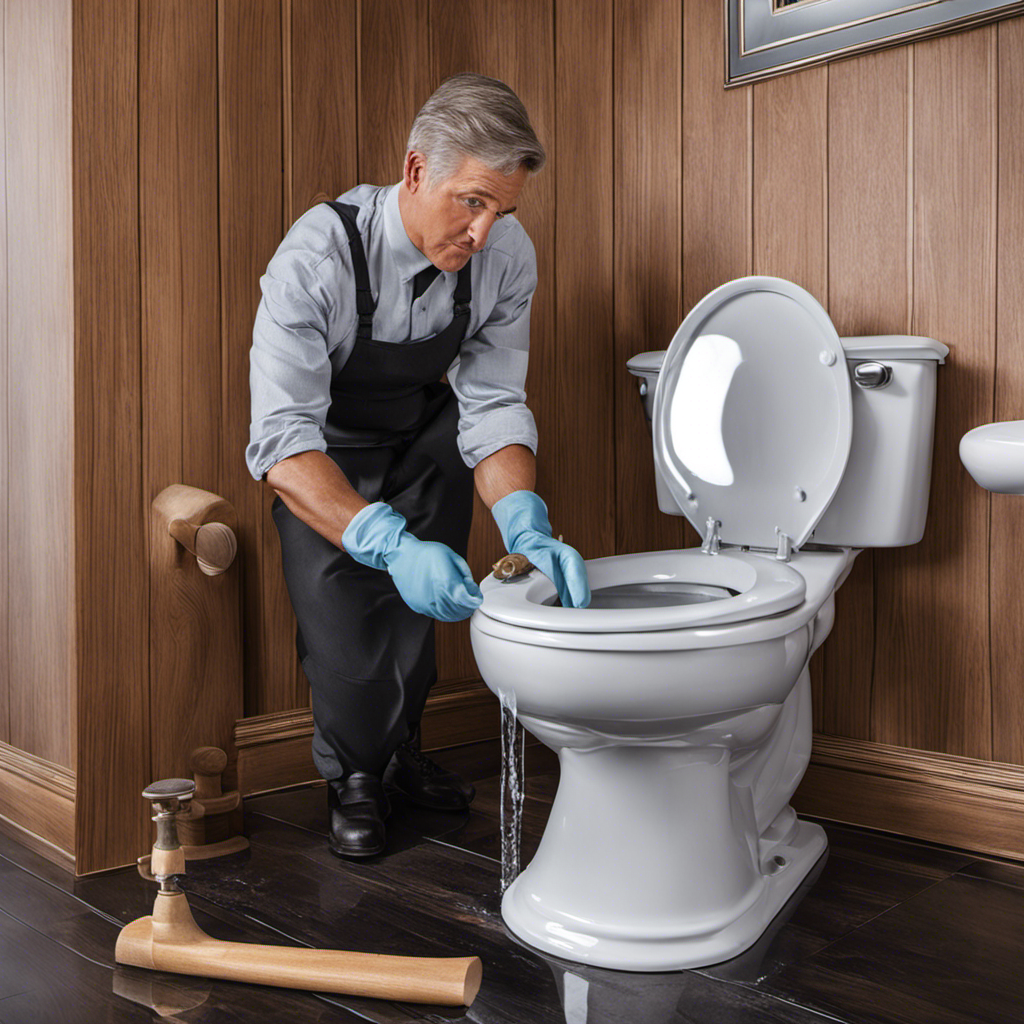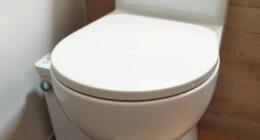I’ve been there, standing in the bathroom, listening to the annoying sound of a running toilet. It’s not only frustrating, but it’s also wasting water and money.
But don’t worry, I’ve got you covered. In this article, I’ll walk you through the step-by-step process of fixing a toilet that keeps running.
From identifying the problem to adjusting the float or fill valve, inspecting and cleaning the flapper, and even replacing it if needed.
By the end, you’ll have the knowledge and confidence to tackle this issue head-on.
Let’s get started!
Key Takeaways
- Check the flapper valve for signs of damage and replace it if necessary.
- Inspect the water valve and supply line for any blockages or obstructions.
- Adjust the float or fill valve to decrease or increase water pressure.
- Regularly check and clean the flapper, and replace it every few years.
Identifying the Problem
First, you’ll want to check if the flapper valve inside the toilet tank is causing the problem. The flapper valve is responsible for sealing the tank and preventing water from continuously running into the bowl. To troubleshoot this issue, remove the tank lid and observe the flapper valve. Look for any signs of damage, such as cracks or deterioration. If the flapper valve is not sealing properly, it may need to be replaced.
Another common issue that can cause a toilet to keep running is a faulty fill valve. This valve controls the flow of water into the tank. If the fill valve is not functioning correctly, it may need to be adjusted or replaced.
Checking the Water Supply
To address the issue, you should start by checking if the water supply is properly connected. Here are some steps to follow:
-
Inspect the water valve: Ensure that the water valve supplying the toilet is fully open. Sometimes, it may have been accidentally turned off, causing low water pressure and a running toilet.
-
Check for blockages: Examine the water supply line for any clogs or obstructions. Debris or mineral deposits can restrict the water flow, leading to a running toilet. If you find any blockages, clear them out carefully.
-
Consider valve replacement: If the water pressure is fine and there are no blockages, the issue might lie with the fill valve. Over time, the valve can become worn out or faulty, causing the toilet to continuously run. In this case, replacing the fill valve is recommended.
Adjusting the Float or Fill Valve
To adjust the float or fill valve, you’ll need to locate the water control assembly inside the toilet tank. This assembly consists of a float, which controls the water level, and a fill valve, which regulates the flow of water into the tank.
If your toilet keeps running, it could be due to a problem with the fill valve. To troubleshoot the fill valve, start by turning off the water supply to the toilet. Then, flush the toilet to drain the tank.
Next, locate the adjustment screw on the fill valve and use a screwdriver to turn it clockwise to decrease the water pressure or counterclockwise to increase it. Make small adjustments and test the toilet after each adjustment to find the optimal water pressure.
Inspecting and Cleaning the Flapper
When it comes to fixing a toilet, one important component to check is the flapper. If you’re experiencing issues with your toilet not flushing properly or constantly running, it could be due to a faulty flapper.
In this discussion, we will explore the different options for replacing the flapper, common problems that can arise with it, and how to properly clean it to keep your toilet functioning smoothly.
Flapper Replacement Options
You can choose between different flapper replacement options, such as the universal flapper or the adjustable flapper. When it comes to flapper maintenance and repair techniques, having the right replacement is crucial. Here are some options to consider:
-
Universal Flapper: This type of flapper is designed to fit most toilet models, making it a versatile choice. It is easy to install and typically comes with a chain and a float to ensure proper functioning.
-
Adjustable Flapper: This flapper allows you to customize the flush volume, which can help conserve water and prevent toilet overflows. It has adjustable settings for different tank sizes and water levels.
-
Dual Flush Flapper: This innovative flapper offers two flushing options – a full flush for solid waste and a half flush for liquid waste. It helps to save water and reduce utility bills.
Choosing the right flapper replacement option can solve your toilet running problem and prevent water waste.
Common Flapper Problems
One common flapper problem is that it doesn’t seal properly, causing water to continuously leak into the toilet bowl. This can be frustrating and wasteful. Flapper maintenance is important to ensure the proper functioning of your toilet. Troubleshooting flapper issues can help you determine the cause of the problem and find a solution. Here are some common problems you may encounter with your flapper:
| Flapper Problem | Possible Causes |
|---|---|
| Flapper doesn’t seal | Worn out flapper, misaligned flapper chain |
| Flapper chain is tangled | Chain is too long or caught on something |
| Flapper is stuck open | Debris or mineral buildup preventing closure |
To fix these issues, you can replace the flapper if it is worn out, adjust the chain length to ensure smooth operation, or clean the flapper to remove any debris or mineral buildup. Cleaning the flapper will be discussed in the next section.
Cleaning the Flapper
Cleaning the flapper is an important step in maintaining the proper functioning of your toilet. The flapper is a rubber valve that controls the flow of water from the toilet tank to the bowl. Over time, debris and mineral deposits can build up on the flapper, causing it to stick or not close properly. This can lead to water leaking from the tank into the bowl, resulting in water overflow and unnecessary water waste.
To clean the flapper, follow these steps:
- Turn off the water supply to the toilet.
- Remove the tank lid and locate the flapper.
- Gently lift the flapper and inspect it for any debris or deposits.
- Use a soft brush or cloth to clean the flapper, removing any buildup.
- Once clean, place the flapper back in its original position and turn the water supply back on.
Regularly cleaning the flapper will help prevent water overflow and ensure your toilet is functioning properly.
Replacing the Flapper
To fix a toilet that keeps running, start by replacing the flapper. The flapper is a rubber valve that is responsible for controlling the flow of water from the tank to the bowl. Over time, the flapper can become worn out or damaged, causing it to not seal properly. This can result in water continuously running into the bowl, leading to a higher water bill and potential water waste.
To replace the flapper, follow these steps:
- Turn off the water supply to the toilet by closing the shut-off valve located behind the toilet.
- Flush the toilet to drain the water from the tank.
- Remove the old flapper by disconnecting it from the flush valve chain or hinge.
- Install the new flapper by attaching it to the flush valve chain or hinge.
- Turn the water supply back on and test the toilet to ensure it is no longer running.
By regularly maintaining and troubleshooting toilet flapper issues, you can prevent water wastage and keep your toilet running efficiently.
| Flapper Maintenance Tips | Troubleshooting Flapper Issues |
|---|---|
| Regularly check the flapper for any signs of wear or damage. | If the flapper is not sealing properly, try adjusting the chain length. |
| Clean the flapper and the flush valve seat to remove any debris or mineral deposits. | Ensure that the flapper is properly aligned with the flush valve. |
| Replace the flapper every few years to ensure optimal performance. | If necessary, replace the flapper with a compatible model for your toilet. |
Fixing a Faulty Flush Handle
The flush handle is an essential component of a functioning toilet, but it can sometimes malfunction.
There are a few common causes for a malfunctioning flush handle, such as a loose handle or a broken lever arm.
Fortunately, fixing a loose handle is a relatively simple task that can be done with just a few basic tools and a little bit of know-how.
Common Causes of Malfunctioning Flush Handle
One common cause of a malfunctioning flush handle is when the lever gets stuck. This can be frustrating, but there are troubleshooting solutions and DIY repair tips that can help you fix the issue.
Here are some common causes of a malfunctioning flush handle:
-
The lever is misaligned: Sometimes, the flush lever can become misaligned, causing it to get stuck. This can be easily fixed by adjusting the lever’s position.
-
The chain is too loose or too tight: If the chain connecting the lever to the flapper is too loose or too tight, it can prevent the flush handle from working properly. Adjust the chain to ensure it has the right amount of tension.
-
The flush handle is broken: Over time, the flush handle can wear out or break. In this case, you may need to replace the handle altogether.
Fixing a Loose Handle
If your flush handle is loose, you can tighten it by adjusting the nut on the back of the handle.
A loose handle can be frustrating, but it’s a common problem that can easily be fixed.
To start, locate the nut on the back of the handle and use a wrench or pliers to tighten it.
Turn the nut clockwise until it is snug against the toilet tank. Be careful not to overtighten, as this can cause damage.
Once the nut is tightened, give the handle a test to ensure it is secure.
If the handle still feels wobbly, you may need to replace it altogether.
Seeking Professional Help if Necessary
When you’re unable to fix the running toilet on your own, you might want to consider seeking professional help. While there are many troubleshooting techniques you can try, sometimes the problem is too complex or requires specialized knowledge.
Here are a few reasons why professional assistance may be necessary:
-
Extensive damage: If your toilet has suffered significant damage or if multiple components need to be replaced, a professional plumber can provide the expertise needed to fix the problem efficiently.
-
Hidden issues: Some issues may not be immediately apparent, such as hidden leaks or faulty valves. A professional can identify and address these underlying problems to prevent further damage.
-
Time and convenience: Hiring a professional saves you time and effort. They have the tools, experience, and knowledge to quickly diagnose and fix the issue, allowing you to get back to your daily routine without any hassle.
Frequently Asked Questions
How Do I Know if My Toilet Is Running?
I can tell if my toilet is running by listening for a continuous sound of water flowing. Other signs include a constantly moving water level in the bowl and a higher water bill. To stop a running toilet, I need to fix the issue causing the continuous water flow.
What Are the Common Causes of a Running Toilet?
When a toilet keeps running, it can be frustrating and keep you up all night with that annoying sound. There are several common causes, but don’t worry, I’ll help you fix it.
Can a Running Toilet Waste a Lot of Water?
Yes, a running toilet can waste a lot of water. It’s important to address this issue to conserve water and reduce the impact on the environment. Fixing a running toilet can help with water conservation efforts.
How Long Can a Running Toilet Go Unnoticed?
It’s surprising how long a running toilet can go unnoticed. I’ll share how to detect it and the consequences of not fixing it promptly. Don’t let this issue waste water and money!
Is It Possible to Fix a Running Toilet Without Replacing Any Parts?
Yes, it is possible to fix a running toilet without replacing any parts. There are alternative solutions and DIY troubleshooting methods that can help identify and resolve the issue. Let me explain.
Conclusion
In conclusion, fixing a toilet that keeps running can be a simple task if you follow the right steps. By identifying the problem, checking the water supply, adjusting the float or fill valve, inspecting and cleaning the flapper, and replacing it if necessary, you can easily solve the issue.
If the flush handle is faulty, that can be fixed too. However, if all else fails, it’s always wise to seek professional help.
Remember, a stitch in time saves nine when it comes to maintaining a fully functional toilet.










